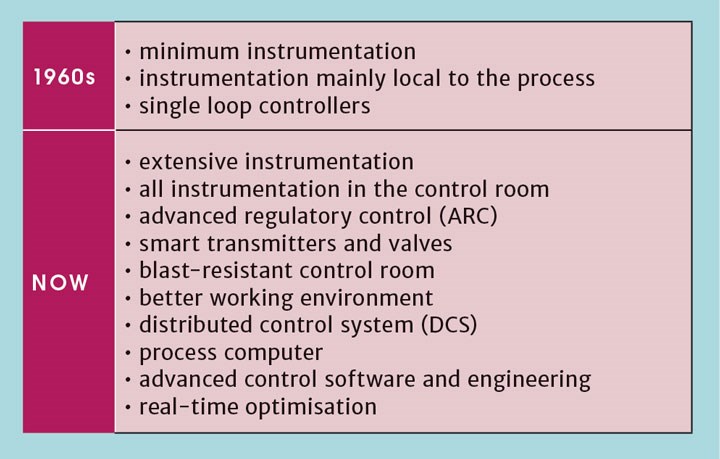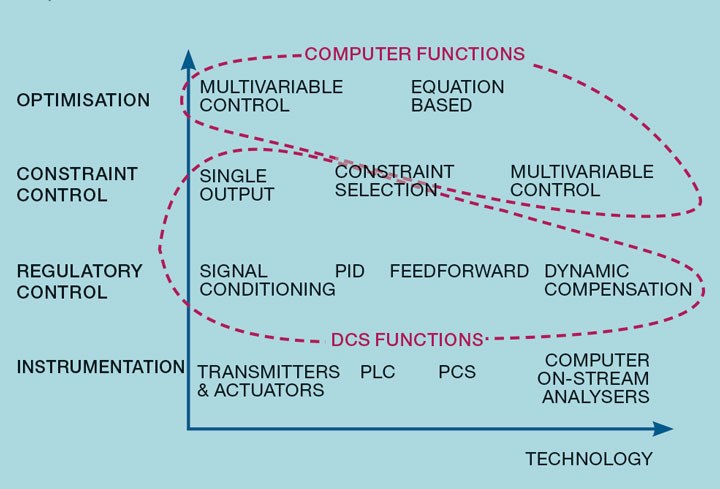Practical Process Control Part 1: Introduction
Myke King introduces a new series on process control, seeking to inspire chemical engineers to exploit untapped opportunities for improvement
GIVEN where this article is published, the chances are that you, the reader, are a chemical engineer. Only a small percentage of chemical engineers involve themselves in process control. So it’s highly probable that the process that you are responsible for has only rudimentary control schemes. Almost certainly there are profit improvement opportunities that are yet to be exploited. This article is the first of a new series that aims to inspire you to take a greater interest. We’ll be highlighting the opportunities and presenting well-proven (and simple) design methods that will aid you in capturing the benefits.
Background
Expertise in the control techniques we’ll be covering is thin on the ground. The academic world is largely to blame for this. While there has been some improvement in recent years, there is a legacy of chemical engineers who found the subject of process control too theoretical with little relevance to industry – to say nothing of it being mathematically challenging. Many, including yours truly, abandoned the course module as a lost cause – learning only later that the mathematics of practical process control need be no more difficult than that covered at high school. The hope is that those academics now teaching process control will also take note of these articles and substitute much of the theory in their lectures with more relevant practical methods.

The shortage of expertise is made worse by the ever-increasing investment that industry is making in process control technologies. Since the 1960s the cost of process control has risen from around 5% to more than 25% of total plant construction cost. Table 1 shows what has changed. Instrumentation has moved from being a necessary evil to a strategically important investment. With the ongoing commitment to digitalisation of the process industry, this trend is set to continue for at least a few more years. Traditionally, only those industries with high throughputs, where a small improvement generates a large profit, could justify the costs involved. So, such investments are common in oil refining and bulk petrochemical manufacture. But costs have been falling for some time. Other process industries, most notably oil and gas production, are waking up to the huge opportunities that have long been present. And so there is an increasing demand on already overstretched sources of expertise.
Of course, such investment would not have been possible without the profession of control and instrument (C&I) engineering. These engineers will have selected the appropriate field instrumentation, designed its installation, commissioned it and provided ongoing support. They will also have specified the control system. However, C&I engineers are primarily concerned with controls essential to the operation. These keep the process stable, safe and operable with a sensible number of staff. However, for little incremental cost, the controls can be enhanced to have a significant impact on profitability. While not exclusively so, it tends to be chemical engineers that understand the process economics and operating objectives and so are better placed to identify and capture the benefits. But they have to do more. They often need to champion the technology to potentially skeptical management who see improved control as an optional extra, incurring unnecessary expense.

It tends to be chemical engineers that understand the process economics and operating objectives and so are better placed to identify and capture the benefits... they often need to champion the technology to potentially skeptical management
Instrumentation
Process control is often presented as hierarchical layers, as displayed along the vertical axis of Figure 1. At the bottom is the hardware of process control – a layer, one would think, essential to the effective implementation of improved control. Too often, insufficient support is provided at this level. This leaves control engineers, working at the higher levels, to deal with inadequate or unreliable instrumentation, either by compromising their designs or just accepting a reduced service factor.
Technology (loosely defined) increases as we move along the horizontal axis. Transmitters and actuators, located outside the control building, fall into the category of field instrumentation. Transmitters include those that measure flow, temperature, pressure and liquid level – using numerous technologies. Actuators will be primarily control valves but include variable speed drives, stack dampers, louvres etc. A decade ago such instrumentation might be considered relatively low in terms of technology but the development of smart instrumentation has dramatically increased the power of such devices – to the point where they can operate autonomously.
Programmable logic controllers (PLC) support relatively basic control functions. Their strength is in the handling of logic and so are often applied to the automation of sequential operations – switching and regenerating driers, for example. Similarly they are often the core of emergency shutdown (ESD) systems. They support some very limited continuous control functions and so can be applied to relatively simple processes, such as water treatment and large-scale beer brewing. More complex continuous processes require the functionality of a distributed control system (DCS). These host a wide range of control algorithms. Indeed, the techniques that we’ll cover in these articles will largely be applied using such systems.
Above the DCS is likely to be a process computer. This might support additional monitoring and a data historian. It is also the platform necessary for higher level controls – now described as advanced process control (APC). This will often comprise multivariable predictive control (MPC) and, in a few cases, closed-loop real-time optimisation (RTO).
Field instrumentation also includes on-stream analysers. Some, such as devices measuring liquid density, are relatively simple. But analytical technology has been advancing for some time. Analysers using near-infrared (NIR) or nuclear mass resonance (NMR) are far more complex in design and application, with an installed cost potentially approaching £1m (US$1.2m).

Regulatory control
The instrumentation layer is largely the domain of the C&I engineer. Chemical engineers, working as control engineers, generally need only an appreciation of the technologies. The layer in which they largely work comprises regulatory control schemes. These can readily be installed within the DCS. By definition a regulatory controller is one which aims to keep the process at a desired condition or set-point (SP). A simple flow controller would fall into this category. But regulatory controls are not necessarily simple. In a later article we’ll cover more complex schemes, such as composition control. These rely on virtual or real on-stream analysers and can incorporate much enhanced control techniques.
At the lowest end of this technology spectrum is signal conditioning. This is a (usually simple) calculation applied to a measurement to make it more suitable for control. We’ll see in future articles that control engineers welcome linear process behaviour; conditioning can provide this linearisation. Or it may be that a measurement is excessively noisy and filtering is required – again a topic of a future article. Or we may want to control a compound measurement, calculated using two or more basic measurements. Examples include fired duty (that we’ll cover in an article looking at combustion control) and pressure compensated tray temperature (part of a future article on distillation controls).
At the core of this layer is proportional-integral-derivative (PID) control. This algorithm has been the basis of almost all regulatory controls for around 85 years and will continue to be so for many years to come. Control system vendors have incorporated a range of enhancements, many of which the industry has yet to fully exploit. Several of the early articles in this series will identify those that offer dramatic improvements in control performance and describe how they should be tuned.
What used to be, in the 1960s and 70s, described as “advanced control” now is more commonly called advanced regulatory control (ARC). It uses algorithms, found in most DCS, to enhance the performance of a regulatory controller. Included here would be feedforward control – a technique that anticipates the need to take corrective action. Other enhancements include dynamic compensation, that would deal with a process that exhibits difficult dynamic behaviour. For example, a distillation column separating isomers to a high purity will have a very large number of trays. It might be several hours before a change made to reboiler duty is reflected in the overheads product composition. The benefit of such enhancements, and how to apply them, will be the subject of future articles.
Constraint control
Moving up to the next layer we begin to hand over some of the decision making to the control system. Instead of specifying set-points we let the controller determine them. We define a strategy; the controller decides on the conditions necessary to meet that strategy. An example would be to control the flow of fuel to a burner but not to exceed the maximum burner inlet pressure. This override scheme is an example of the simplest constraint control. It has two inputs but a single output – the position of the fuel gas control valve. Normally determined by the required flow, its position might be overridden to avoid excessive pressure. This involves some signal selection logic. Again the article on combustion control will cover this scheme in detail. Controllers manipulating more than one variable are described as multivariable. For example, a strategy might involve adjusting both reflux and reboil on a distillation column to meet both top and bottom quality specifications. We’ll show, in a future article, that the interactive nature of distillation makes it unlikely we could achieve this with two single-input, single-output controllers. Since the mid-80s, MPCs have become commonplace, many with dozens of manipulated variables. These now count as APC. They often capture the lion’s share of profit improvement but, since they adjust set-points, can become expensive mistakes if the lower level of regulatory control is found wanting.
Optimisation
At the top of the control hierarchy is optimisation – a very subjective term. Staff that develop the weekly production plan are optimising the process, as are those engineers who figure out what today’s operating conditions should be. Here we are talking about closed-loop optimisation, where set-points are adjusted or constraint strategies modified – potentially every minute. A range of technologies might be applicable. MPC requires some form of economic objective to decide on what strategy to follow and so can have significant optimisation functionality. But most are linear and so cannot identify the peak of a curved profit function. Rigorous, equation-based products support high fidelity simulation of the process but are extremely costly and require high levels of expertise to maintain them. More recent developments aim to provide a more pragmatic technology, falling between MPC and rigorous RTO, that captures the majority of the benefits in a more manageable way.
Next issue
In the next article we’ll address process dynamics. Understanding these is an essential first step to effective control design. we’ll explain what they are and how they can be determined from simple plant tests.
The topics featured in this series are covered in greater detail in Myke King's book, Process Control – A Practical Approach, published by Wiley in 2016.
This is the first in a series that provides practical process control advice on how to bolster your processes. To read more, visit the series hub at https://www.thechemicalengineer.com/tags/practical-process-control/
Disclaimer: This article is provided for guidance alone. Expert engineering advice should be sought before application.
Recent Editions
Catch up on the latest news, views and jobs from The Chemical Engineer. Below are the four latest issues. View a wider selection of the archive from within the Magazine section of this site.




